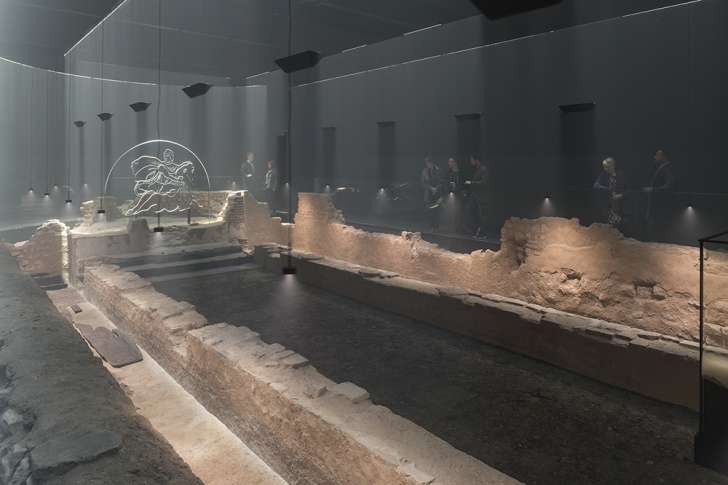
A Roman temple has been restored to its original site seven metres below the City of London, using sound, lights and misty haze to bring the ruin back to life.
The London Mithraeum, a temple made by the cult of Mithras that dates back to Roman times, was discovered on the site in the 1950s, but its remains were moved to make way for new construction. Now, Bloomberg has installed a new recreation on the original site, and it’s opening to the public on November 14.
The three-story London Mithraeum Bloomberg SPACE brings visitors back to the ancient Roman settlement Londinium using lights, haze, and sound. Created by the New York–based design firm Local Projects, it’s designed to make you feel like you’re descending through time, until you reach the ruins at what was once ground level, almost 23 feet below modern London’s streets, where the exhibition recreates what researchers think the rituals of the cult might have looked and sounded like 2000 years ago.
“People walk into the Mithraeum, and it’s dark and a bit cold and super quiet, and then as the ritual builds, the entire temple builds around you, almost like standing inside a three-dimensional hologram,” Jake Barton, the founder of Local Projects, tells Mental Floss. “It’s such a magical experience, to see architecture appear and disappear around you. It never ceases to shock and excite our visitors.”
Local Projects worked for years with consulting curator Nancy Rosen Incorporated, artistic consultant Matthew Schreiber, and exhibition architects from Studio Joseph to figure out how to combine the story of the cult, the plentiful ancient artifacts found on the site, the modern castings that represent the objects the temple would have contained, and the ruins themselves, which have been reconstructed using the original building materials (with some help from supplemental stone).
The challenge was to showcase the historical aspects of the site without just showing off a big pile of rocks, illuminating the religious activities and human stories that make it interesting in the first place. “The hard thing in all museums is, how do you make it real, tangible and human?” Barton says. Their solution was to dedicate the upper floors of the Mithraeum to historical context, then leave the lower level to be its own experience.
Six hundred of the 14,000 ancient artifacts of the site are on display on the ground floor, and once you descend underground, a mezzanine features interactive exhibits where you can hear from experts and learn about the beliefs of the cult of Mithras and the rituals performed in the temple. The lower level, where the ruins of the temple are located, is left spare in order to evoke the reality of those cult activities.













